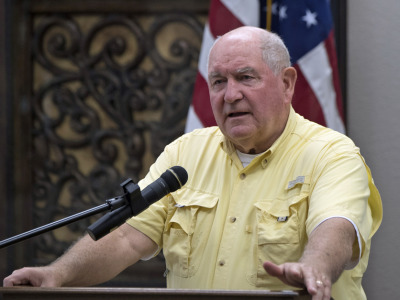President Donald Trump has proven that he’s willing to open USDA’s deep pockets to help farmers overcome the twin challenges of a trade war and pandemic. But if economists are correct, many farmers still face years of financial challenges ahead.
How the government responds will likely depend on who’s elected in November. Former Vice President Joe Biden is promising to "dramatically expand" the Conservation Stewardship Program with the twin goals of supporting farm income and addressing climate change by paying farmers for practices that cut greenhouse gas emissions. Biden's plan also promises to target additional aid, including loans, to new and beginning farms and to local and regional agriculture.
Former Agriculture Secretary Tom Vilsack, who is advising Biden on ag policy, tells Agri-Pulse that he thinks conservation payments could be ramped up quickly, even without relying on a broader climate bill. He also suggests that a Biden administration could carry on with use of USDA’s Commodity Credit Corp. to provide aid to farmers.
Biden is offering "a strong, progressive, doable” farm policy with the “capacity to expand significantly the income capacity of our farms,” Vilsack told Biden supporters on a recent online event.
As for what Trump would do in a second term, his campaign told the American Farm Bureau Federation in a survey released Wednesday that a new farm bill, due in 2023, "must do a better job of sustaining them through these tough times" while avoiding any "new regulatory or climate requirements on already struggling farmers." The Trump campaign didn't offer specific policy but said "future farm bills must focus on building on the key pillars of our domestic farm policy including a strong crop insurance system, voluntary conservation programs, and increased agricultural research."
Meanwhile, Agriculture Secretary Sonny Perdue has repeatedly made clear that Trump is determined to protect farmers form the impact of policies they can’t control.

Ag Secretary Sonny Perdue
Farmers "would much rather have … checks coming through the scales at the elevator than coming through the mailbox,” Perdue said, when asked if the ad hoc payments provided over the past three years could be continued.
“But I can tell you one thing, President Trump is committed to not let China through retaliation interfere with that. He’s not going to allow COVID interfere with that’s where these funds are coming from. I’m hopeful, he’s hopeful, that we don’t have to support farmers like that. And they’re hopeful as well that we don’t have to.”
Citing large recent Chinese purchases of U.S. corn, soybeans and other commodities, Perdue also expressed optimism that China will meet its commitments under the “phase one” agreement with Trump to buy $80 billion in U.S. farm exports over 2020 and 2021. “Exports are going really well in the phase one” deal, Perdue said.
China remains well short of its target, however. USDA currently is forecasting that U.S. ag exports to China at $14 billion for fiscal 2020, which ends Sept. 30, and just $18.5 billion in FY21.
USDA’a latest farm income forecast estimated government payments would soar to $37 billion this year, a 66% increase over 2019 and more than triple the average level of federal support from 2010 through 2017. Looked at another way, government payments will account for 40% of net farm income this year, the highest level since 2000, according to economist Nathan Kaufmann of the Kansas City Federal Reserve.
Economic forecasts don’t promise much improvement in 2021. The University of Missouri’s Food and Agricultural Policy Research Institute projects farm cash receipts will rise modestly from $357 million in 2020 to $367 million in 2021, but that’s still below the $371 million farmers received in 2019, and much of that forecast improvement for 2021 is in just three sectors — oilseeds, cattle and poultry.
University of Illinois economists project growers will lose $73 an acre on corn and $18 an acre on soybeans in 2021 without the continuation of some form of ad hoc payments, such as the Market Facilitation Program payments provided in 2018 and 2019, or the Coronavirus Food Assistance Program payments Trump authorized this spring.
According to the University of Illinois projections, corn growers this year will qualify for $50 an acre in CFAP payments to go with $45 an acre in payments from the two major farm bill programs (Price Loss Coverage or Agriculture Risk Coverage) on this year’s crop, ensuring that those farmers can almost break even.
For 2021, farm program payments are estimated to total only $32 an acre, and there is no assurance of CFAP or MFP continuing into next year.
Joe Glauber, a former chief economist for USDA, says the biggest difference between Biden’s and Trump’s farm policy appears to be Biden’s linkage to climate change and his pledge to make U.S. agriculture net-zero in greenhouse gas emissions.
His plan relies heavily on the expansion of the Conservation Stewardship Program, both through federal funding and through contributions from corporations, individuals and foundations interested in offsetting their emissions. “This will not only help combat climate change, which Vice President Biden has called an existential threat, but also create additional revenue sources for farmers at a time when many are struggling to make ends meet,” the Biden plan says.
The plan doesn't specify a proposed level of funding, although it would sharply reverse the recent trajectory of CSP. The 2018 farm bill cut CSP by about $12.4 billion over 10 years by shifting the program from an annual acreage cap to a funding limit, which was set at $700 million in 2019, rising to $1 billion in 2023.
Glauber says Biden would presumably need a new revenue source, such as a carbon tax, to fund his climate policies, including the expansion of CSP. Biden hasn’t endorsed a carbon tax. Glauber also noted that “uptake on (conservation) programs has been slow in the past.”
Vilsack tells Agri-Pulse that Biden has other options to fund his plan and get money in farmers’ hands more quickly, possibly through a new stimulus bill.
"The Trump administration certainly showed the power of CCC if there are no arbitrary limits placed on it, as is currently the case,” Vilsack said. “There is also a possibility of another coronavirus package that could either be passed in a new administration or could be implemented in whole or in part by a new administration.”
The “arbitrary” CCC limit Vilsack is clearly referring to is the restriction that successive Congresses placed on his use of the account after he used it to make disaster assistance payments in 2010. Republicans, who saw the payments as politically motivated, agreed to lift the restriction after the Trump administration was preparing to mount the trade war with China.

Former Ag Secretary Tom Vilsack
Vilsack also emphasized the CSP funding would supplement, not replace, traditional commodity programs.
Other aspects of Biden’s plan focus on beginning farms and local and regional agriculture systems. His proposals include doubling the $100,000 maximum loan amount under USDA’s microloan program for new and beginning farmers.
To help small-scale and medium-size producers, the plan also proposes helping them supply the Defense Department as well as other state and federal institutions and schools and hospitals.
“This will allow these farmers to negotiate their own prices. And it will help farmers identify markets for specialty crops and secondary products, like ice cream produced by diary farmers to bring in additional revenue,” the Biden plan says.
For more news, go to www.Agri-Pulse.com


